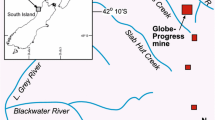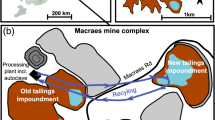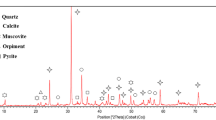Abstract
Antimony, a toxic metalloid similar to arsenic, is present at variable levels in most gold-bearing rocks. Antimony is soluble in the surface environment, so antimony (Sb) mobilization in mine waters is an environmental issue around gold mines. The Reefton gold mine was originally developed in gold-bearing quartz veins; Sb concentrations were low (<100 mg/kg) compared to arsenic (As) concentrations (>1,000 mg/kg), and the mine waters had low dissolved Sb (<0.1 mg/L). A second stage of gold mineralization at Reefton involved brecciation and cataclasis of quartz veins and wall rocks, with addition of stibnite (Sb2S3). Processing of this ore has resulted in higher dissolved Sb in mine waters (0.1–1 mg/L), even after water treatment that removes most dissolved As (to 0.01 mg/L) by adsorption to suspended iron oxyhydroxide. Competition between As and Sb for adsorption sites on iron oxyhydroxide particles may have resulted in partial exclusion of the more weakly adsorbed Sb. The high rainfall (2,000 mm/year) at Reefton ensures adequate dilution of mine waters after discharge. The Macraes gold mine has no stibnite, and most Sb is in solid solution in the abundant arsenopyrite (Sb up to 2,000 mg/kg). Pit waters have both Sb and As dissolved up to 0.1 mg/L, partly because of evaporative concentration in a low-rainfall environment. Macraes tailings waters have high As (up to 3 mg/L) but negligible Sb (<0.001 mg/L). Reefton mine gold-bearing concentrate, containing stibnite, is transported 700 km to be processed by autoclave oxidation and cyanidation at the Macraes mine. This introduction of additional Sb to the Macraes site substantially increases the Sb content of the process stream periodically. Tailings from this process have up to 3 wt% Sb, dispersed through As-rich iron oxyhydroxides that are formed in the autoclave. The Sb-rich tailings are strongly diluted (approximately 100:1) by the Macraes tailings, and adsorption of Sb to iron oxyhydroxides in the tailings piles ensures that there has been no increase in the Sb content of the tailings water since the Reefton concentrate has been added at Macraes.








Similar content being viewed by others
References
Adriano DC (1986) Trace elements in the terrestrial environment. Springer, Heidelberg, p 533
Ainsworth N, Cooke JA, Johnson MS (1990) Distribution of antimony in contaminated grassland: I: vegetation and soils. Environ Pollut 65:65–77
Ashley PM, Craw D (2004) Structural controls on hydrothermal alteration and gold-antimony mineralisation in the Hillgrove area, NSW, Australia. Miner Depos 39:223–239
Ashley PM, Craw D, Graham BP, Chappell DA (2003) Environmental mobility of antimony around mesothermal stibnite deposits, New South Wales, Australia and southern New Zealand. J Geochem Explor 77:1–14
Ashley PM, Craw D, Tighe MK, Wilson NJ (2006) Magnitudes, spatial scales and processes of environmental antimony mobility from orogenic gold-antimony mineral deposits, Australasia. Environ Geol 51:499–508
Blowes DW, Jambor JL, Hanton-Fong CJ, Lortie L, Gould WD (1998) Geochemical, mineralogical and microbiological characterization of a sulfide-bearing carbonate-rich gold-mine tailings impoundment, Jontel, Quebec. Appl Geochem 13:687–705
Christie AB, Brathwaite RL (2003) Hydrothermal alteration in metasedimentary rock-hosted orogenic gold deposits, Reefton goldfield, South Island, New Zealand. Miner Depos 38:87–107
Craw D (2000) Water-rock interaction and acid neutralization in a large schist debris dam, Otago, New Zealand. Chem Geol 171:17–32
Craw D (2002) Geochemistry of late metamorphic hydrothermal alteration and graphitisation of host rock, Macraes gold mine, Otago Schist, New Zealand. Chem Geol 191:257–275
Craw D (2003) Geochemical changes in mine tailings during a transition to pressure-oxidation process discharge, Macraes Mine, New Zealand. J Geochem Explor 80:81–94
Craw D (2006) Pressure-oxidation autoclave as an analogue for acid-sulfate alteration in epithermal systems. Miner Depos 41:357–368
Craw D, Nelson M (2000) Geochemical signatures of discharge waters, Macraes mine flotation tailings, east Otago, New Zealand. N Z J Mar Freshw Res 34:597–613
Craw D, Windle SJ, Angus PV (1999) Gold mineralization without quartz veins in a ductile-brittle shear zone, Macraes Mine, Otago Schist, New Zealand. Miner Depos 34:382–394
Craw D, Koons PO, Chappell DA (2002) Arsenic distribution during formation and capping of an oxidized sulfidic minesoil, Macraes mine, New Zealand. J Geochem Explor 76:13–29
Craw D, Falconer D, Youngson JH (2003) Environmental arsenopyrite stability and dissolution: theory, experiment, and field observations. Chem Geol 199:71–82
Craw D, Wilson NJ, Ashley PM (2004) Geochemical controls on the environmental mobility of Sb and As at mesothermal antimony and gold deposits. Trans Inst Mining Metall (Appl Earth Sci) 113:B3–B10
Dzombak DA, Morel FMM (1990) Surface complexation modeling: hydrous ferric oxide. Wiley Interscience, New York City, p 393
Filella M, Belzile N, Chen Y-W (2002) Antimony in the environment: a review focused on natural waters. I. Occurrence. Earth Sci Rev 57:125–176
Giggenbach WF, Sheppard DS, Robinson BW, Stewart MK, Lyon GL (1994) Geochemical structure and position of the Waiotapu Geothermal Field, New Zealand. Geothermics 23:599–644
Goldfarb RJ, Groves DI, Gardoll S (2001) Orogenic gold and geologic time: a global synthesis. Ore Geol Rev 18:1–75
Haffert L, Craw D (2008) Mineralogical controls on environmental mobility of arsenic from historic mine processing residues, New Zealand. Appl Geochem 23:1467–1483
Hedenquist JW, Arribas AR, Gonzalez-Urien E (2000) Exploration for epithermal gold deposits. In: Hagemann SG, Brown PE (eds) Gold in 2000, vol 13. Reviews in Economic Geology, pp 245–277
Hewlett L, Craw D, Black A (2005) Comparison of arsenic and trace metal contents of discharges from adjacent coal and gold mines, Reefton, New Zealand. Mar Freshw Res 56:983–995
Kang M, Kamei T, Magara Y (2003) Comparing polyaluminum chloride and ferric chloride for antimony removal. Water Res 37:4171–4179
Krause E, Ettel VA (1988) Solubility and stability of scorodite, FeAsO4.2H2O: new data and further discussion. Am Miner 73:850–854
Langmuir D (1997) Aqueous Environmental Geochemistry. Prentice-Hall, Upper Saddle River, NJ, USA, p 600
Lottermoser BG (2003) Mine wastes: characterization, treatment and environmental impacts. Springer, Berlin, p 277
McComb KA, Craw D, McQuillan AJ (2007) ATR-IR spectroscopic study of antimonate adsorption to iron oxide. Langmuir 23:12125–12130
Mercer KL, Tobiason JE (2008) Removal of arsenic from high ionic strength solutions: effects of ionic strength, pH, and preformed vs in situ formed HFO. Environ Sci Technol 42:3797–3802
Mitchell M, Maw L, Angus PV, Craw D (2006) The Macraes gold deposit in east Otago. In: Christie AB, Brathwaite RL (eds) Geology and exploration of New Zealand mineral deposits, vol 25. Australasian Institute of Mining and Metallurgy Monograph, pp 313–318
Mok WM, Wai CM (1990) Distribution and mobilization of arsenic and antimony species in the Coeur d’Alene River, Idaho. Environ Sci Technol 24:102–108
Mori C, Orsini A, Migon C (1999) Impact of arsenic and antimony contamination on benthic invertebrates in a minor Corsican river. Hydrobiologia 392:73–80
Nesbitt BE, Muelenbachs K, Murowchick JB (1989) Genetic implications of stable isotope characteristics of mesothermal Au deposits and related Sb and Hg deposits in the Canadian Cordillera. Econ Geol 84:1489–1506
Petrie BS, Craw D, Ryan CG (2005) Geological controls on refractory ore in an orogenic gold deposit, Macraes mine, New Zealand. Miner Depos 40:45–58
Pitcairn IK, Teagle DAH, Craw D, Olivo GR, Kerrich R, Brewer TS (2006) Sources of metals and fluids in orogenic gold deposits: insights from the Otago and Alpine Schists, New Zealand. Econ Geol 101:1525–1546
Reed MH (1997) Hydrothermal alteration and its relationship to ore fluid composition. In: Barnes HL (ed) Geochemistry of Hydrothermal Ore Deposits. Wiley, New York City, pp 303–366
Roddick-Lanzilotta AJ, McQuillan AJ, Craw D (2002) Infrared spectroscopic characterisation of arsenate(V) ion adsorption from mine waters, Macraes Mine, New Zealand. Appl Geochem 17:445–454
Seal RR, Hammarstrom JM (2003) Geoenvironmental models of mineral deposits: examples from massive sulfide and gold deposits. In: Jambor JL, Blowes DW, Ritchie AIM (eds) Environmental aspects of mine wastes, vol 31. Mineralogical Association of Canada. Short course, pp 11–50
Shotyk W, Krachler M, Chen B (2005) Anthropogenic impacts on the biogeochemistry and cycling of antimony. In: Sigel A, Sigel H, Sigel RKO (eds) Biogeochemistry, availability and transport of metals in the environment, metal ions in biological systems, vol 44. M Dekker, New York City, pp 177–203
Tien VN, Chaudhary DS, Ngo HH, Vigneswaran S (2004) Arsenic in water: concerns and treatment technologies. J Ind Eng Chem 10:337–348
Vink B (1996) Stability relations of antimony and arsenic compounds in the light of revised and extended Eh-pH diagrams. Chem Geol 130:21–30
Waychunas GA, Fuller CC, Rea BA, Davis JA (1996) Wide-angle X-ray scattering (WAXS) study of “two-line” ferrihydrite structure: effect of arsenate sorption and counterion variation and comparison with EXAFS results. Geochim Cosmochim Acta 60:1765–1781
Wilson N, Webster-Brown J, Brown K (2007) Controls on stibnite precipitation at two New Zealand geothermal power stations. Geothermics 36:330–347
Acknowledgments
This research was financed by the NZ Foundation for Research Science and Technology, and the University of Otago. The NZ Branch of Australasian Institute of Mining and Metallurgy provided a scholarship to LM for the study. The project would have been impossible without the enthusiastic co-operation and support from Oceana Gold Ltd personnel at both Reefton and Macraes mines, especially Debbie Clarke, Simone Vellekoop, Russell Pearce, Craig McIntosh, Brent Hill, Nick Whetter, Mark McCulloch, Tony Frater, Quenton Johnston, Melanie Rosak, and Pat Chave. Kat Lilly, Brent Pooley and Damian Walls provided expert laboratory assistance. Comments by two anonymous reviewers helped to improve the substance and presentation of the manuscript.
Author information
Authors and Affiliations
Corresponding author
Rights and permissions
About this article
Cite this article
Milham, L., Craw, D. Antimony Mobilization through Two Contrasting Gold Ore Processing Systems, New Zealand. Mine Water Environ 28, 136–145 (2009). https://doi.org/10.1007/s10230-009-0071-y
Received:
Accepted:
Published:
Issue Date:
DOI: https://doi.org/10.1007/s10230-009-0071-y




